|
|
| Rajasthan |
 |
Jaipur
Ajmer
Pushkar Fair
Udaipur
Chittorgarh
|
Mount Abu
Jodhpur
Jaisalmer
Bikaner
Ranthambor
|
Barmer
Balotra and Kanana
Alwar
Bharatpur-Deeg
Rest of India
|
 Rajasthan, India's
desert state, was once a collection of princely kingdoms where feudal
traditions still carry on amidst forts and palace hotels.
Bharatpur is famous for its 29 sq km bird sanctuary which
has the largest concentration and variety of birdlife in Asia. Throughout
the year Bharatpur's native population of tree and water birds can be
seen, the latter breeding in July-August. However, the sanctuary has
gained worldwide attention as being the winter home of several migratory
species including the endangered Siberian crane. The capital city,
Jaipur, was the stronghold of a clan of rulers whose
three hill forts and series of palaces in the city are important
attractions. Known as the Pink City because of the colour of the stone
used exclusively in the walled city, Jaipur's bazaars sell embroidered
leather shoes, blue pottery, tie and dye scarves and other exotic wares.
Western Rajasthan itself forms a convenient circuit, in the heart of the
Thar desert which has shaped its history, lifestyles and architecture.
Jodhpur's exquisitely lovely fort, now a museum; art
deco royal palace converted into a hotel, and quaint markets, all vividly
testify to the history of the princely state. Jaisalmer, in the heart of
the desert, is surrounded by sand-dunes which rendered the sand coloured
fort impregnable. Today it is an inhabited city whose chief attraction is
lacy filigree of pierced stonework facades of private houses, and a series
of ornately carved Jain temples. Bikaner too has echoes
of the past in its sandstone palace, temples and cenotaphs. In the north
of Rajasthan, Shekhavati is approachable by road from Jaipur. The greatest
attraction here are the deserted mansions of local merchants decorated
with a profusion of wall paintings. The subjects and styles vary greatly,
and are not encountered elsewhere in India. Nearby Dundlod and Mandawa are
forts, now converted into charming hotels. Seldom visited Bundi is
remarkable for its palace fort and gallery of fine frescoes, executed in
the style for which the state is famous. Approachable by road from Jaipur
are Ajmer and Pushkar.Ajmer’s pre-eminence is due to the shrine of a Muslim saint who is believed to fulfill one’s wishes. Nearby Pushkar has one of the very few temples dedicated to Brahma the Creator. The sleepy town with its placid lake is catapulted into prominence for 10 days every November as India’s most splendid camel fair takes place here, attended by thousands of locals flashing jewellery and exuding colour. For the thousands of tourists who visit Pushkar, accommodation is in the form of tents which cater to all budgets Rajasthan, India's
desert state, was once a collection of princely kingdoms where feudal
traditions still carry on amidst forts and palace hotels.
Bharatpur is famous for its 29 sq km bird sanctuary which
has the largest concentration and variety of birdlife in Asia. Throughout
the year Bharatpur's native population of tree and water birds can be
seen, the latter breeding in July-August. However, the sanctuary has
gained worldwide attention as being the winter home of several migratory
species including the endangered Siberian crane. The capital city,
Jaipur, was the stronghold of a clan of rulers whose
three hill forts and series of palaces in the city are important
attractions. Known as the Pink City because of the colour of the stone
used exclusively in the walled city, Jaipur's bazaars sell embroidered
leather shoes, blue pottery, tie and dye scarves and other exotic wares.
Western Rajasthan itself forms a convenient circuit, in the heart of the
Thar desert which has shaped its history, lifestyles and architecture.
Jodhpur's exquisitely lovely fort, now a museum; art
deco royal palace converted into a hotel, and quaint markets, all vividly
testify to the history of the princely state. Jaisalmer, in the heart of
the desert, is surrounded by sand-dunes which rendered the sand coloured
fort impregnable. Today it is an inhabited city whose chief attraction is
lacy filigree of pierced stonework facades of private houses, and a series
of ornately carved Jain temples. Bikaner too has echoes
of the past in its sandstone palace, temples and cenotaphs. In the north
of Rajasthan, Shekhavati is approachable by road from Jaipur. The greatest
attraction here are the deserted mansions of local merchants decorated
with a profusion of wall paintings. The subjects and styles vary greatly,
and are not encountered elsewhere in India. Nearby Dundlod and Mandawa are
forts, now converted into charming hotels. Seldom visited Bundi is
remarkable for its palace fort and gallery of fine frescoes, executed in
the style for which the state is famous. Approachable by road from Jaipur
are Ajmer and Pushkar.Ajmer’s pre-eminence is due to the shrine of a Muslim saint who is believed to fulfill one’s wishes. Nearby Pushkar has one of the very few temples dedicated to Brahma the Creator. The sleepy town with its placid lake is catapulted into prominence for 10 days every November as India’s most splendid camel fair takes place here, attended by thousands of locals flashing jewellery and exuding colour. For the thousands of tourists who visit Pushkar, accommodation is in the form of tents which cater to all budgets
Also in Rajasthan is the wildlife sanctuary of Sariska where a royal hunting lodge has been converted into a hotel. Sariska’s wildlife includes the tiger, panther, deer and antelope.
|
| Top |
JAIPUR
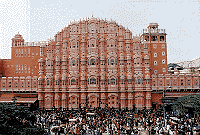 Founded in AD 1727 by Sawai Jaisingh II, Jaipur the capital of Rajasthan is popularly known as the Pink City with broad avenues and spacious gardens. The capital of Rajasthan, Jaipur is steeped in history and culture. Here the past comes alive in magnificent forts and palaces, blushed pink, where once lived the maharajas. The bustling bazaars of Jaipur, famous for Rajasthani jewellery, fabric and shoes, possess a timeless quality and are surely a treasure-trove for the shoppers. This fascinating city with its romantic charm takes you to an epoch of royalty and tradition. Founded in AD 1727 by Sawai Jaisingh II, Jaipur the capital of Rajasthan is popularly known as the Pink City with broad avenues and spacious gardens. The capital of Rajasthan, Jaipur is steeped in history and culture. Here the past comes alive in magnificent forts and palaces, blushed pink, where once lived the maharajas. The bustling bazaars of Jaipur, famous for Rajasthani jewellery, fabric and shoes, possess a timeless quality and are surely a treasure-trove for the shoppers. This fascinating city with its romantic charm takes you to an epoch of royalty and tradition.
Marwar Festival (October)
An annual festival of dance and music, celebrating the classical ’Maand’ style of folk music. The festival brings alive the legend, folklore and romantic lifestyle of Rajasthan’s rulers.
PLACES OF INTEREST
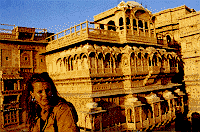 City Palace & Museum 3.5 kms, Hawa Mahal 3 kms, Jantar Mantar 3.5 kms, Dolls Museum, Zoo, Amber Pal & Jaigarh Fort 11 kms, Gaitor 8 kms, Vidhyadharji Ka Bagh 7 kms, Jal Mahal, Nawab Ki Haveli, Galta, Sisodia Palace & Garden 8 kms.
City Palace & Museum 3.5 kms, Hawa Mahal 3 kms, Jantar Mantar 3.5 kms, Dolls Museum, Zoo, Amber Pal & Jaigarh Fort 11 kms, Gaitor 8 kms, Vidhyadharji Ka Bagh 7 kms, Jal Mahal, Nawab Ki Haveli, Galta, Sisodia Palace & Garden 8 kms.
Mehrangarh Fort (5 km)
One of the largest forts in India, it is unsurpassed in beauty and grandeur. Innumerable palaces in the fort, interspersed with sprawling courtyards, are intricately carved. Various folk musicians and bands gather here on important occasions and perform against the magical backdrop of the fort – reviving the regal splendour of a bygone era.
Jaswant Thada (5 km)
The 19th century royal cenotaph, a creation in white marble was built in commemoration of Maharaja Jaswant Singh II and displays some rare portraits of Jodhpur’s rulers.
Umaid Bhawan Palace
The only palace built in the 20th century as a famine relief project, which gave employment to hundreds of people for 16 years. Its sculpted lawns with sandstone pavements and bouquets of bougainvillea bushes, offer a lovely sight. The palace now runs as a hotel with a part of it retained as a museum.
Mandore (8 km)
The capital of ancient Marwar, it is truly an oasis in the desert with its beautifully laid out gardens. The sprawling greenery of peepal, banyan, palms and plantains along with swirling fountains and lovely peacocks make Mandore a visual treat, The main attraction is the ’Hall of Heroes’ housing sixteen gigantic figures chiselled out of a single rock and the cenotaphs of the former maharajas of Jodhpur.
Clock Tower and Sardar Market
One can go shopping for Jodhpur tie-and-dye textile, embroidered leather shoes, lacquerware, antiques, carpets and puppets, amidst the setting of traditional haat bazaar at the well planned Sardar Market near the Clock Tower.
Mahamandir Temple (2 km)
Built in 1812, this is an old walled town with few hundred houses. The temple with 84 beautifully carved pillars is an architectural wonder.
Kailana Lake (11 km)
An artificial lake on the Jaisalmer road. An idyllic picnic spot with spectacular sunsets.
Balsamand Lake and Palace (7 km)
A picturesque artificial lake with a summer palace on its banks. There are lush orchards of mango, guava and other fruits.
EXCURSIONS
Nahargarh Fort 15 kms, Sanganer 16 kms, Ramgarh Lake 30 kms and Shekhawati 168 kms
Sardar Samand Lake and Palace (55 km)
As you drive to the lake, the picturesque countryside with lovely villages and smiling folks on the way, offer a spectacular sight. A rendezvous with chinkara and black buck might add more fun to the drive.
Osian (65 km)
An ancient town of the Thar Desert, renowned for a cluster of ruined Brahmanical and Jain temples dating from 8th to 11th century. The most important temples are the Surya or Sun Temple and the Sachiya Mata Temple. The latter has a ’shikhar’ clustered by a row of tarrets, an ambulatory and a large assembly hall with an elaborate ceiling.
Guda Bishnoi (25 km)
These are immaculately kept villages of Bishnoi community-staunch believers in the sanctity of plant and animal life. Khejri trees and varieties of deer are the attractions of the villages.
Tiger Safari
The State Govt. of Rajasthan is planning to develop a Biological Park in the 50 kms. area behind the Nahargarh Hills. As per a press release dated 4th Sep 2000, the work for this project will start next month and will take about 6 months for completion. As per the official sources, 25 to 30 Tigers, Deers, Bulbulls, and other wild animals will be kept in the park. We will keep you updated on further developments.
|
GENERAL INFORMATION
Climate: Summer Mean Max. 42.2 C Mean Min. 36.6 ’C Winter Mean Max. 27.5 ’C Mean Min. 15.5 ’C
Clothing: Summer light tropical or cotton Winter Woollen.
Season : October to March
|
| Top |
AJMER
Founded in 1100 AD by Aijpal Chauhan, Ajmer derives its name from `Ajaya Meru' the invincible hill, at the foot of which the present city stands.
PLACES OF INTEREST & EXCURSIONS
Adhai-Din-Ka-Jhonpra, Ana Sagar Lake, Circuit House, Dargah of Khwaja Moinuddin Chishti, Soniji ka Nasiyan, Mayo College, Swami Dayanand Saraswati Smarak, Taragarh Fort and the Museum. Pushkar 11 kms, Foy Sagar Lake 12 kms and Kishangarh 27 kms.
|
GENERAL INFORMATION
Best Season : September to April.
|
| Top |
PUSHKAR FAIR
There is a temple dedicated to lord Brahma on the lake side. Mammoth Pushkar fair is held here every autumn ( October / November ).
|
| Top |
UDAIPUR
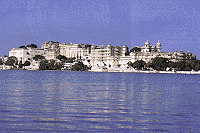 A famous city of Rajasthan state, standing on the banks of lake Pichola with white marble palaces. Udaipur is one of the most romantic cities of India A famous city of Rajasthan state, standing on the banks of lake Pichola with white marble palaces. Udaipur is one of the most romantic cities of India
PLACES OF INTEREST
EXCURSIONS
Kankroli 64 km, Eklingli 21 km, Haldighati 42 km, Jaisamand Lake 50 kms, Nathdwara 42 kms, Ranakpur 90 kms, Rishabhdeo 65 kms .
|
GENERAL INFORMATION
Season : Throughout the year. Best season from October to March.
|
| Top |
CHITTORGARH
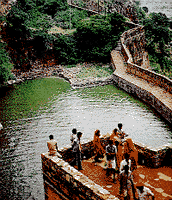 The history of Chittor is one of the most stirring chapters in Indian history for it was there that the flower of Rajput chivalry sprang to life and the immense stretch of its sacred walls and ruined palaces relate the saga of innumerable sieges and heroism which has almost become a myth now. Western railways connect Chittorgarh on the metre guage with Ajmer, Delhi, Jaipur, Ratlam, Udaipur. However the convenient railhead is Udaipur. Rajasthan State Roadway Transport Corporation operates regular bus service from Agra 557 kms, Ajmer 182 kms, Delhi 578 kms, Jaipur 320 kms, Jodhpur, Kota 000 kms, Mount Abu 390 kms and Udaipur 115 kms to Chittorgarh. The history of Chittor is one of the most stirring chapters in Indian history for it was there that the flower of Rajput chivalry sprang to life and the immense stretch of its sacred walls and ruined palaces relate the saga of innumerable sieges and heroism which has almost become a myth now. Western railways connect Chittorgarh on the metre guage with Ajmer, Delhi, Jaipur, Ratlam, Udaipur. However the convenient railhead is Udaipur. Rajasthan State Roadway Transport Corporation operates regular bus service from Agra 557 kms, Ajmer 182 kms, Delhi 578 kms, Jaipur 320 kms, Jodhpur, Kota 000 kms, Mount Abu 390 kms and Udaipur 115 kms to Chittorgarh.
PLACES OF INTEREST
Fort, jay Stambha, Kirti Stambha, Rana-Kumbha Palace, Padmini Palace, Meera Temple and Kumbha Shyam Temple and Kalika Mata Temple, State Archaeological Museum. Nagari: 14 kms. An ancient town in Rajasthan, it is situated north of Chittor. According to excavation, a civilisation flourished here from the Maurya to the Gupta dynasty. Notable excavations indicate these having both the serenity of Hinduism and the sacrifice of Buddhism. Excavations are continuing.
|
| Top |
MOUNT ABU
Famous for its exquisitively carved marble temples, Mount Abu (1219 metres) is a pretty hill resort in the State of Rajasthan.
PLACES OF INTEREST
Adhar Devi Temple, Andhra Point (Honeymoon Point), Dilwara Jain Temple (Open from 1200 hrs. to 1800 hrs for non Jains), Gaumukh, Nakki Lake, Red Temple, Shri Raghunathji Temple, Sunset Point, Traver's Tank.
EXCURSIONS
Ambaji 50 km, Achalgarh 11 km, Guru Shikar 15 km, Ranakpur 168 km.
|
GENERAL INFORMATION
Best Season : Mid-March to June and Mid-September to December
|
| Top |
JODHPUR
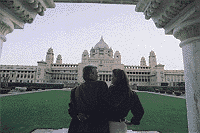 The imperial city is replete with amazing legends of romance and heroism. A land where the past thrives still. This is the fortified city of Jodhpur, standing a wary sentinel to the great Thar Desert. Beckoning you to the wilderness of fascinating dunes, rocky terrain and thorny vegetation.
The imperial city is replete with amazing legends of romance and heroism. A land where the past thrives still. This is the fortified city of Jodhpur, standing a wary sentinel to the great Thar Desert. Beckoning you to the wilderness of fascinating dunes, rocky terrain and thorny vegetation.
Once the capital city of the Marwar state, it was founded in 1459 by Rao Jodhaji - chief of the Rathore Clan of Rajputs who claimed descent from Lord Rama. A major trade centre of 16th century, the city, today, has grown to become the second largest city of Rajasthan, retaining the medieval splendour.
The city is encompassed by a high wall, 10 km. long with eight gates. Within the city, atop a rocky hill, stands the massive fort, 120 mtrs. above the plains.
Packed with history, art and culture, this princely state is a treasure – trove of some exquisite palaces, forts, temples and havelis – standing a testimony to the imperial grandeur. But what entices the most in Jodhpur is the traditional lifestyle, festivity and smiling people.
PLACES OF INTEREST
EXCURSIONS
|
GENERAL INFORMATION
Best Season : October to February
|
| Top |
JAISALMER
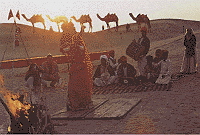 Golden splendour amid the desert
Golden splendour amid the desert
Jaisalmer – the golden beauty, etched in yellow sandstone. Perched atop the Trikuta Hill, it stands tall against miles of gleaming sand. Epitomising the desolate, awesome charm of the desert.
Jaisalmer, the city of the golden fort is a fantasy in yellow sandstone in the heart of the Thar Desert. The city was founded in 1156 by Rawal Jaisal, a Bhatti Rajput King.
Legend has it, that Lord Krishna – the head of Yadav Clan, foretold Arjuna that a remote descendent of Yadav Clan would build his kingdom atop the Trikuta Hill. His prophecy was fulfilled, when in 1156 AD Rawal Jaisal, a descendant of Yadav Clan and a Bhatti Rajput, founded the city of Jaisalmer.
This amber-hued city, in the heart of the desert, dazzles gloriously in the early morning. The sunset has a peculiar glow here. As the night descends, the sky goes up in flames, which fade leaving a few embers, till it becomes black. A breathtaking sight indeed!
Jaisalmer is famous for cobbled streets, strewn with palaces, forts, temples and havelis. Every house, here, is exquisitely carved, having filigreed work all over. These houses date back to 12th – 15th century. And hence Jaisalmer is called the ’Museum city’.
Filled with colour, festivity and smiles, Jaisalmer is truly a memorable experience across the shimmering sands.
The Desert Festival (February)
During the three day long festival, Jaisalmer reverberates with music, colour and joy, displaying its glorious past and rich culture. Under the full moon, the vigorous folk dancers sway to the enchanting music. The turban tying contest and Mr. Desert contest add to the enthusiasm. A trip to Sam sand dunes, where one can view folk musicians performing and even enjoy a camel safari, marks the finale of this colourful extravaganza
PLACES OF INTEREST
Fort, Jain Temple, Gyan Bhandar, Garhsisar, Salim Sing Ki Haveli, Patwon ki Haveli, Nathmalji ki Haveli & Amar Sagar, Mool Sagar.
Jaisalmer Fort
Renew yourself amid the past galore, as you visit the commanding Jaisalmer Fort. The fort stands guard over the desertscape from its 250 feet high perch on the hill with its wall following the contours of the hills. The steep cobblestone pathways leading to the royal palace pass through four gates. The sharp twists and turns make the fort invincible. The fort has five interconnected palaces with ’jaali’ screens and dainty ’jharokhas’ – all showpieces of Jaisalmer artisans’ talent. Within the fort are three exquisitely sculptured Jain temples,
Gadsisar Lake
A rain water lake, adorned with an arched gateway. Many small shrines and temples are festooned all around the lake. Today, it is an ideal picnic spot, famous for boating.
Salim Singh-ki-Haveli
Witness the legendary architectural wealth of Jaisalmer at Salim Singh’s haveli, truly unsurpassed in splendour. Of particular note are the blue roof and rows of peacocks below the arched balconies. The haveli was once the residence of the Mohta family, ministers of Jaisalmer rulers.
Patwon-ki-Haveli
It is the grandest mansion in Jaisalmer, not to be missed at all. This five haveli wonder has its ceiling supported by exquisitely carved pillars and its delicately chiselled balconies surely leave you mesmerised.
Nathmalji-ki-Haveli
This haveli was carved by two brothers. One worked on right side and the other on left, but the harmony in design exists still. Screened windows, projected balconies and intricate carvings illustrate superb craftsmanship.
Jain Temples – Within the citadel are the splendorous Jain temples, dedicated to Rishabdevji, Sambhavnathji and Parshvanathji. The Parshvanathji Temple is the oldest and the most beautiful of the Jain temples. Human and animal figures are carved on the walls of its sanctum and the rising dome or ’shikhar’ is crowned by an amalak and a waterpot containing a lotus flower.
Gyan Bhandar or Library
A part of the Jain temples, the library contains some of the oldest manuscripts of India.
EXCURSIONS
Devikot (40 kms), Ramdeora (150 kms), Sam Sand Duna (42 kms), Lodhruva (17 kms), Bada Bagh (6 kms), Wood Fossil Park (17 kms), Desert National Park (40 kms), Barmer (153 kms).
Lodurva (16 km)
A trip to this important pilgrimage centre for Jains, once the ancient capital of Jaisalmer rulers, is a rewarding experience. A masterpiece of architectural grandeur is ’Toran’ or the ornate arch at the main entrance with its exquisite carvings. ’Kalpatru’ or the divine tree is another attraction.
Sam Sand Dunes (42 km)
No trip to Jaisalmer is complete without a visit to the most picturesque dunes. The ripples on the wind-caressed dunes create enchanting mirages – a photographer’s delight. Various cultural programmes are organised against the backdrop of these fascinating dunes. Adventure freaks can go out on a camel safari - getting the real feel of the desert on the camel-back.
Wood Fossil Park (17 km)
This park, lying on the Barmer Road, takes you back to the jurassic period with 180 million year old fossils, which are the geological landmarks for the study of the Thar Desert.
Desert National Park
Come, see the rolling landscape of the Sam sand dunes. Head on for a wild experience, as you may encounter the Indian Gazelle, Chinkara Eagle and exotic avian variety in this 3000 sq. km. vast protected Biosphere Reserve. The park lies to the south-west of Jaisalmer.
|
| Top |
BIKANER
Founded in 1488, Bikaner is a desert city built on an elevation and surrounded by a long embattled wall pierced by five gates. A magnificient fort built betwen 1588 & 1593 by Raja Raj Singh dominates the city. Season: October to March.
Sheer beauty in the desert is the royal fortified city of Bikaner. Lying at the northern tip of the famous triangle of the desert cities, Bikaner stands on a slightly raised ground and is circumscribed by a long embattled wall having five entrance gates.
The genesis of Bikaner dates back to 1488, when a Rathore prince, Rao Bikaji, son of Rao Jodhaji of Jodhpur, chose a barren wilderness called ’Jangladesh’ and transformed it to a charming city called ’Bikaner’, after the founder’s name. Its location on the ancient caravan routes, which linked Central Asia and North India with the Gujarat seaports, made Bikaner a bustling trade centre in the times of yore.
Bikaner’s forts, palaces and temples – magnificent creations in red and yellow sandstone, are living manifestations of its rich historical and architectural legacy. One can feel the medieval aura pervading the city’s lifestyle.
Not only do the traditions come alive here in colourful bazaars and havelis, but Bikaner is also famous for the best riding camels in the world. One can witness gaily caparisoned camels at the spectacular Camel Festival at Bikaner, held annually.
Camel Festival (January)
Held in the month of January every year on the full moon night, the festival is dedicated to the indispensable ship of the desert. A fascinating spectacle of camel performances. Camel races, camel dances and camel rides, along with the joy, colour and vigour unique to Rajasthan, make this a joyous event.
Kolayatji Fair (October)
Held in October-November at Kolayat (53 km. from Bikaner). Devotees throng here in large numbers to take a holy dip in the Kolayat Lake on the full moon of Kartik or Poornima and offer prayers to Karni Mata.
PLACES OF INTEREST
Junagarh Fort, Lalgarh Palace, Ganga Golden Jubilee Museum.
Junagarh Fort
Revel in the architectural splendour, as you take an intimate look at this imposing fort, built by Akbar’s contemporary Raja Rai Singh. Within the fort are thirty seven palaces, pavilions Suraj Pol or the Sun Gate is the main entrance to the fort. The palaces worth visiting are Chandra Mahal, Phool Mahal and Karan Mahal. The palaces, exquisitely built in red sandstone and marble are ornate with mirror work, carvings and paintings. An array of kiosks and balconies embellish the fort at intervals, breaking the monotony. A museum with valuable miniature paintings and rare antiques is also located in the Junagarh Fort.
Lalgarh Palace
The magnificent fort in red sandstone, a fascinating juxtaposition of the Oriental style and European luxury that leaves you truly mesmerised. Designed by Sir Swinton Jacob for Maharaja Ganga Singh almost -90 years ago, this is an extraordinary monument. The palace has a billiards room, a library, a cards room and a smoking room. Belgian chandeliers, cut – glass ornaments, oil paintings and lamps add to its charm.
Bhandeshwar Jain Temples
(5 km) Beautiful 16th century Jain temples, dedicated to the 23rd Tirthankar Parshvanathji.
Other important temples of Bikaner include the Lakshminathji, Ratan Bihariji, Shiv Bari, and Nagnechiji temple. The Bhaironji Temple at Kodamdesar, about 40 kms from Bikaner, is another noteworthy temple
EXCURSIONS
Bhand Sagar Temple 5 km, Camel Breeding Farm 10 km, Devi Kund 8 km, Gajner Wildlife Sanctuary 32 kms, Deshnok's Karniji Temple 33 kms.
Camel Breeding Farm (8 km)
Acquaint yourself with the indispensable ship of the desert at this camel research and breeding centre, the only one of its kind in Asia.
Devi Kund (8 km)
This is a royal crematorium with cenotaphs of the house of Bikaji Rathore. Many decorated Chhatris, built in the memory of the Bika dynasty, offer splendid example of the Rajput architecture.
Gajner Wildlife Sanctuary and Palace
Watch flocks of imperial sand grouse, as you wander through the lush foliage of woods located on the Jaisalmer road. Gajner is also home to nilgai, chinkara, wild boar and black buck. Gajner Palace, a summer resort of kings built on the beautiful lake along the sanctuary, is a spot worth visiting.
Karni Mata Temple, Deshnoke (30 km)
Offer your prayers to Karni Mata – an incarnation of goddess Durga, at this 600 year old temple. The temple offers a haven to rats. Devotees feed the rats, owing to the belief that these rodents will be reincarnated as holy men. The entrance archway of the temple is intricately carved in marble.
Kolayat (50 km)
A sacred spot, dedicated to Kapil Muni. The temple here is the venue for a fair in the month of Kartik (Oct.- Nov.), attracting thousands of pilgrims. Kolayat is an idyllic picnic spot as well.
Shiv Bari Temple (6 km)
Built in the 19th century by Maharaja Doongar Singhji, the temple is encircled by a high wall. Beautiful paintings and a Nandi Bull facing the Shiva Lingam are the attractions of the temple.
Havelis
An array of havelis, built in red stone and intricately carved, embellish the city.
Kalibanga (205 km)
The remnants of the pre-Harappan and Harappan settlements have been found at this place in Hanumangarh District. Surely of interest to archaeology enthusiasts.
|
| Top |
RANTHAMBOR (Sawai-Madhopur Wildlife Sanctuary)
Nestling at the foot of Aravalli Hills is Ranthambor National Park, a famous tiger reserve under Project Tiger. Ranthambor blends history of Rajput valour with scenic natural beauty and is an ideal gateway for a quiet holiday.
PLACES OF INTEREST & EXCURSIONS
Amreshwar Mahadev 8 kms, Mahavirji 110 kms, Kela Devi 125 kms, Shivad 30 kms, Khandar 60 kms, Rameshwaram 90 kms in Khandar Area.
|
GENERAL INFORMATION
Best Season : November to May
|
| Top |
| Top |
BARMER
"Vestibule of the Rajasthani Culture"
Tiny yet lively town in the desert, Barmer is all colour, warmth and tradition. As you visit this tiny town, colourfully attired natives welcome you with a bright smile.
Renowned for intricate embroidery work, multi - hued traditional costumes and block printing of textiles, Barmer is a shopper’s delight. The city is also famous for carved wood furniture.
Every year in the month of March, Barmer is at its colourful best during the exuberant Barmer Festival – a perfect time to visit this desert town
|
| Top |
BALOTRA AND KANANA
Kanana is the venue for the Sheetla Saptmi Mela and is close to Balotra known for its textile printing and dying work
|
| Top |
ALWAR
Alwar with its historic fort, palaces & beautiful gardens offers an unforgettable experience. The medieval fort crowning a scarped hill overlooks the town below. Alwar was founded by Rao Pratap Singh in 1775 A.D
PLACES OF INTEREST
City Palace, Museum, Puran vihar, Sagar (tank) Bala Fort, Vinay Vilas Mahal.
EXCURSIONS
Siliserh : 15 km. Set quietly against wooded hills. Siliserh is famous for its Lake and enchanting Palace. This resort overlooking the lake is converted into a hotel. A motor launch is available for cruising on the lake
|
GENERAL INFORMATION
Climate : Summer Max. 37 Deg C Min. 24 Deg C Winter Max. 31 Deg C Min. 11 Deg C
Rainfall : 63.5 cms.
Best Season : October to March.
|
BHARATPUR-DEEG
Bharatpur, an impregnable fortified city is today famous for the nearby Keoladeo Ghana Bird Sanctuary. Once the shooting preserve of royalty, it is perhaps the most spectacular water-bird sanctuary in India
PLACES OF INTEREST
Bharatpur Bird Sanctuary 3 Km. Also known as the Keoladeo Ghanga Sanctuary, it is famous for rare avian species. Stretching over a 29 sq. km. marshy area it is an ideal terrain for migratory birds. Some 353 species live and breed within the park, some of which are egrets, darters, cormorants, grey herons, sarus crane, siberian crane, rosy headed pelican etc. There are also a number of spotted deer, sambar, nilgai, wild boar, python and porcupine. Jeepable roads that form a network through the marshland and boats that canbe painted through weeds make for easy viewing of the birds. All visitors are required to obtain a permit from the Warden or Ranger at the entrance of the parl.
Bharatpur Fort This magnificient 18th century fort built by Raja Suraj Mal was also known as Loha Gadh and proved to be impregnable.
Government Museum The museum in the fort houses sculptures, inscriptions and exhibits of art and culture of the region.
Bharatpur Palace This royal monument is a brilliant blend of Mughal and a Rajput architecture. There is also a museum in the central wing with a few exhibits dating to the 2nd century A.D.
EXCURSIONS
Deeg (32 km): Renowned for its forts, palaces and beautiful Mughal gardens this used to be the royal summer resort of the rulers of Bharatpur, Deeg is 35 km from Mathura, 75 km from Alwar and 152 km from Delhi.
|
GENERAL INFORMATION
Climate : Summer Max. 45 C Min. 37 C Winter Max. 31 C Min. 21 C
Season : October to February
|
| Top |
|
|
